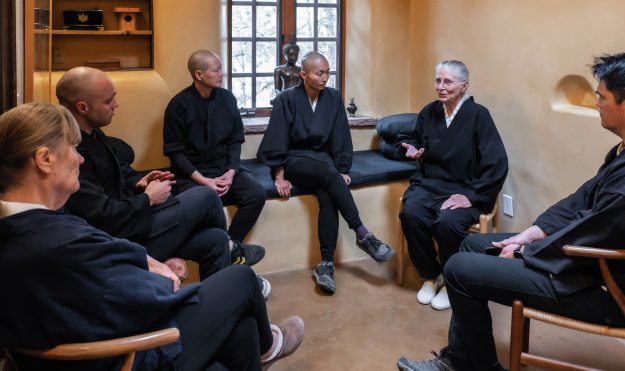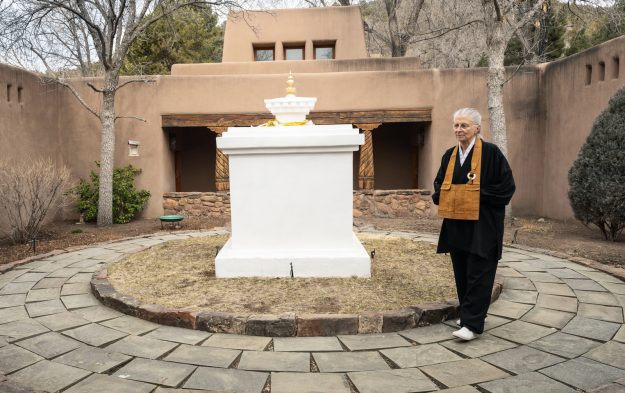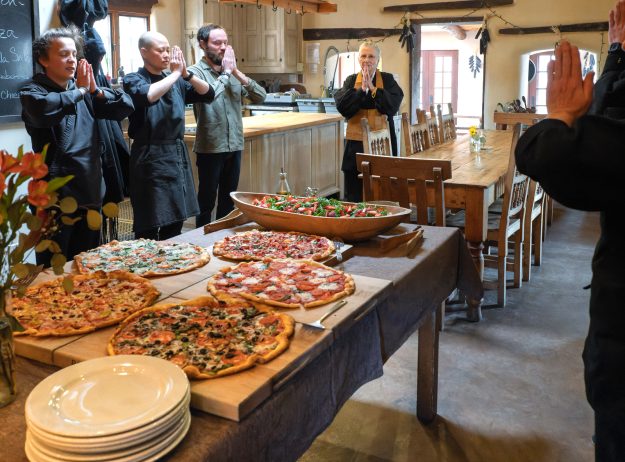7:00 a.m. The Upaya Zen Center zendo is called Dokanji, or “Circle of the Way Temple.” The name was given by Upaya’s good friend Sensei Kazuaki Tanahashi when the temple was dedicated in 2001. Upaya’s residents and local sangha sit there every morning and evening. It is a truly beautiful space that is treasured by many.

8:30 a.m. Upaya’s priests come from all over: Hong Kong, Thailand, Singapore, Italy, the States, and Mexico. We emphasize working together as peers to support the resident body and local sangha through activities like cooking for the unsheltered and teaching in prisons and recovery centers. We meet every month or so to review how our programs can best serve the community.

10:00 a.m. For many years, we have grown corn, beans, and squash at Upaya’s Three Sisters’ Garden. Here I’m examining some new garden additions with fellow priest Wendy Dainin Lau, who is also an emergency room physician and co-director of Upaya’s Nomads Clinic, which serves in Dolpo, Nepal.

11:00 a.m. I’ve studied calligraphy with Sensei Kazuaki Tanahashi for many years. During the pandemic, I painted nearly every day and began sharing my paintings with practitioners around the world.

12:00 p.m. The stupa in the courtyard of Cerro Gordo Temple is the first Tibetan stupa built in the United States. Upaya’s residents steward this beautiful temple and enjoy sitting daily midday zazen in its small, beautiful hall. I circumambulate the stupa several times each month.

1:00 p.m. Before eating lunch, we recite a food offering that I composed in 1984: “Earth, water, fire, air, and space combine to make this food. Numberless beings gave their lives and labors that we may eat. May we be nourished that we may nourish life.”

Once a year I confer the Buddhist precepts. I haven’t been able to do this in person for the past two years, but in the spring of 2022 I was able to do this for several of Upaya’s residents, plus forty others who joined us virtually.
Jukai at Upaya
In our Zen tradition, Jukai is a ceremony in which the Buddhist precepts are given to someone wishing to follow the path of the bodhisattvas. It is perhaps the first ceremony offered by the Buddha to his disciples. I have always felt so humbled conferring the precepts. When I recite them to recipients, I remember when I first received the Buddhist precepts myself in 1975. Little did I know that my life would irreversibly change after taking this rite of passage.
When I look into the faces of those receiving the kai, or “precepts,” I know that for some this ceremony will be a similarly formative experience—a time and space where they will see who they really are and how their lives touch this world. At Upaya Zen Center, we ask those who undergo Jukai to make significant preparation, including glossing the precepts and making three different charts: The Women Ancestor Chart, the Buddhist Ancestor Chart, and a chart mapping their personal spiritual lineage. They also sew a rakusu (a small patch of robe also known as a kesa) on which we will write the Verse of the Kesa, their dharma name, and my name.
The heart of Jukai is reflected in the notion of refuge: we take refuge not only in the Buddha, dharma, and sangha, but also in the deep aspiration to be of benefit to others and to serve in our broken world. Receiving the precepts opens us up to a path that is unending—one that is laid down in walking. It is a gift that keeps giving, a lifelong teaching, and a constant guidepost for correcting our course as we meet the world and ourselves.
—Roshi Joan Halifax
♦
See more of Roshi Joan Halifax’s day on Instagram @tricyclemag.
Check out previous installments of “A Day in the Dharma” featuring Vanessa Zuisei Goddard, Mindy Newman, Wangmo Dixey, Josh Korda, Sensei Koshin Paley Ellison, the members of the Village Zendo, and six Buddhist teachers in quarantine.
Thank you for subscribing to Tricycle! As a nonprofit, we depend on readers like you to keep Buddhist teachings and practices widely available.
